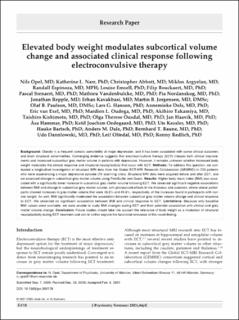Elevated body weight modulates subcortical volume change and associated clinical response following electroconvulsive therapy
Opel, Nils; Narr, Katherine L; Abbott, Christopher; Argyelan, Miklos; Espinoza, Randall; Emsell, Louise; Bouckaert, Filip; Sienaert, Pascal; Vandenbulcke, Mathieu; Nordanskog, Pia; Repple, Jonathan; Kavakbasi, Erhan; Jorgensen, Martin B.; Paulson, Olaf B.; Hanson, Lars G.; Dols, Annemieke; van Exel, Eric; Oudega, Mardien L.; Takamiya, Akihiro; Kishimoto, Taishiro; Ousdal, Olga Therese; Haavik, Jan; Hammar, Åsa Karin; Ødegaard, Ketil Joachim; Kessler, Ute; Bartsch, Hauke; Dale, Anders M.; Baune, Bernhard T; Dannlowski, Udo; Oltedal, Leif; Redlich, Ronny
Journal article, Peer reviewed
Published version

Åpne
Permanent lenke
https://hdl.handle.net/11250/2838327Utgivelsesdato
2021Metadata
Vis full innførselSamlinger
- Department of Biomedicine [710]
- Registrations from Cristin [9791]
Sammendrag
Background: Obesity is a frequent somatic comorbidity of major depression, and it has been associated with worse clinical outcomes and brain structural abnormalities. Converging evidence suggests that electroconvulsive therapy (ECT) induces both clinical improvements and increased subcortical grey matter volume in patients with depression. However, it remains unknown whether increased body weight modulates the clinical response and structural neuroplasticity that occur with ECT.
Methods: To address this question, we conducted a longitudinal investigation of structural MRI data from the Global ECT-MRI Research Collaboration (GEMRIC) in 223 patients who were experiencing a major depressive episode (10 scanning sites). Structural MRI data were acquired before and after ECT, and we assessed change in subcortical grey matter volume using FreeSurfer and Quarc.
Results: Higher body mass index (BMI) was associated with a significantly lower increase in subcortical grey matter volume following ECT. We observed significant negative associations between BMI and change in subcortical grey matter volume, with pronounced effects in the thalamus and putamen, where obese participants showed increases in grey matter volume that were 43.3% and 49.6%, respectively, of the increases found in participants with normal weight. As well, BMI significantly moderated the association between subcortical grey matter volume change and clinical response to ECT. We observed no significant association between BMI and clinical response to ECT.
Limitations: Because only baseline BMI values were available, we were unable to study BMI changes during ECT and their potential association with clinical and grey matter volume change.
Conclusion: Future studies should take into account the relevance of body weight as a modulator of structural neuroplasticity during ECT treatment and aim to further explore the functional relevance of this novel finding.
